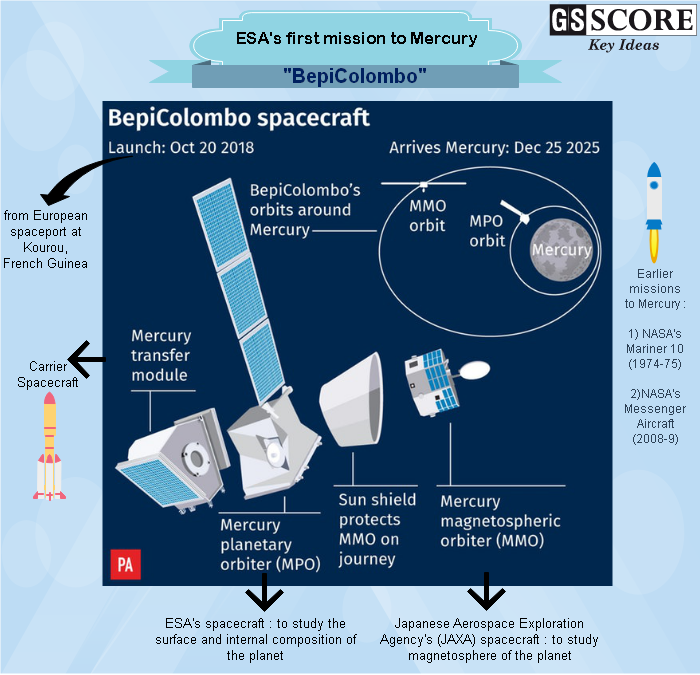

- European Space Agency (ESA) is all set to launch its first mission to Mercury- BepiColombo.
- The four-tonne spacecraft will be launched into orbit by ESA’s rocket Ariane 5 from the European spaceport at Kourou, French Guiana.
- The spacecraft will then make a 5.2bn mile (8.5bn km) journey over seven years to reach its destination by 2025.
Context
- European Space Agency (ESA) is all set to launch its first mission to Mercury- BepiColombo.
- The four-tonne spacecraft will be launched into orbit by ESA’s rocket Ariane 5 from the European spaceport at Kourou, French Guiana.
- The spacecraft will then make a 5.2bn mile (8.5bn km) journey over seven years to reach its destination by 2025.
About
- BepiColombo is a planned European-Japanese mission to Mercury. It is a joint mission between ESA and the Japan Aerospace Exploration Agency (JAXA) and will be executed under ESA leadership.
- The mission includes a carrier spacecraft called the Mercury Transfer Module (MTM) – which supplies electrical power during interplanetary cruise – and two separate orbiters. The European Space Agency's spacecraft is the Mercury Planet Orbiter (MPO) and the Japanese Aerospace Exploration Agency's spacecraft is the Mercury MagnetosphericOrbiter (MMO).
- The MPO will study the surface and internal composition of the planet and the MMO will study Mercury’s magnetosphere i.e. the region of space around the planet that is influenced by its magnetic field.
- The spacecraft will take about seven years to get to Mercury, using several gravity assists from other planets along the way. It will fly by Earth and Venus in 2020, Venus in 2021 and Mercury itself between 2021 and 2025. These flybys will slow down the spacecraft enough to be captured by Mercury's gravity in December 2025.
- Europe’s space scientists have identified the mission as one of the most challenging long-term planetary projects, because Mercury’s proximity to the Sun makes it difficult for a spacecraft to reach the planet and to survive in the harsh environment found there.

Significance
- ESA noted that going to Mercury would help scientists not only understand how the planet had formed, but also give more information generally about the solar system's formation. BepiColombo’s Objectives include:
- Investigate the origin and evolution of a planet close to the parent star.
- Study Mercury as a planet: its form, interior structure, geology, composition and craters.
- Examine Mercury's vestigial atmosphere (exosphere): its composition and dynamics.
- Probe Mercury's magnetized envelope (magnetosphere): its structure and dynamics.
- Determine the origin of Mercury's magnetic field.
- Investigate polar deposits: their composition and origin.
- Perform a test of Einstein's theory of general relativity.
- Mercury is a poorly explored planet. So far, only two spacecraft have visited the planet: NASA’s Mariner 10, which flew past three times in 1974–5 and returned the first close-up images of the planet, and NASA’s MESSENGER spacecraft, which performed three flybys (two in 2008 and one in 2009) before entering orbit around the planet in March 2011.
- The information obtained when BepiColombo arrives will throw light not only on the composition and history of Mercury, but also on the history and formation of the inner planets in general, including Earth.
- The scientific interest in going to Mercury lies in the valuable information that such a mission can provide to enhance our understanding of the planet itself as well as the formation of our Solar System; information which cannot be obtained with observations made from Earth.
Learning Aid




